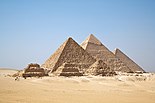Giza pyramid complex
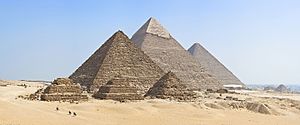 The three main pyramids at Giza, together with subsidiary pyramids and the remains of other structures | |
| Location | Giza, Greater Cairo,Egypt |
|---|---|
| Region | Middle Egypt |
| Coordinates | 29°58′34″N31°7′58″E/ 29.97611°N 31.13278°E |
| Type | Monument |
| History | |
| Periods | Early Dynastic PeriodtoLate Period |
| Site notes | |
| Website | |
| Part of | "Pyramid fields from Giza to Dahshur"part ofMemphis and its Necropolis – the Pyramid Fields from Giza to Dahshur |
| Includes | |
| Criteria | Cultural: i, iii, vi |
| Reference | 86-002 |
| Inscription | 1979 (3rdSession) |
| Area | 16,203.36 ha (162.0336 km2;62.5615 sq mi) |
TheGiza pyramid complex(also called theGiza necropolis) inEgyptis home to theGreat Pyramid,thePyramid of Khafre,and thePyramid of Menkaure,along with their associated pyramid complexes and theGreat Sphinx.All were built during theFourth Dynastyof theOld Kingdomofancient Egypt,betweenc. 2600– c. 2500 BC.The site also includes several temples, cemeteries, and the remains of a workers' village.
The site is at the edge of theWestern Desert,approximately 9 km (5.6 mi) west of theNile Riverin the city ofGiza,and about 13 km (8.1 mi) southwest of thecity centre of Cairo.It forms the northernmost part of the 16,000 ha (160 km2;62 sq mi)Pyramid Fieldsof theMemphis and its NecropolisUNESCOWorld Heritage Site,inscribed in 1979.[1]The pyramid fields include theAbusir,Saqqara,andDahshurpyramid complexes, which were all built in the vicinity of Egypt's ancient capital ofMemphis.[1]Further Old Kingdom pyramid fields were located at the sitesAbu Rawash,Zawyet El Aryan,andMeidum.
The Great Pyramid and the Pyramid of Khafre are the largestpyramids built in ancient Egypt,and they have historically been common as emblems ofAncient Egypt in the Western imagination.[2]They were popularised inHellenistictimes, when the Great Pyramid was listed byAntipater of Sidonas one of theSeven Wonders of the World.It is by far the oldest of the Ancient Wonders and the only one still in existence.
Maadi settlements
[edit]The earliest settlement of the Giza plateau predates the pyramid complexes. Four jars from theMaadi culturewere found at the foot of the Great Pyramid, likely from a disturbed earlier settlement.[3]Further Maadi settlement near the site was uncovered during work on the Greater Cairo Wastewater Project.[4]Recent reassessment of the radiocarbon dating puts the Maadi culture'seponymous settlementtoc. 3800– c. 3400 BC,which is also the likely maximum possible range for the Giza remains.[5]
Pyramids and Sphinx
[edit]
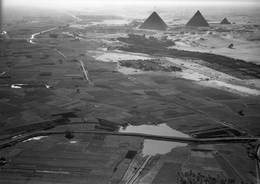

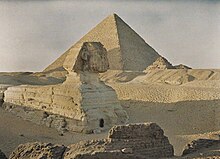
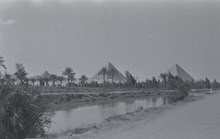

The Giza pyramid complex consists of theGreat Pyramid(also known as the Pyramid of Cheops orKhufuand constructedc. 2580– c. 2560 BC), the slightly smallerPyramid of Khafre(or Chephren) a few hundred metres to the south-west, and the relatively modest-sizedPyramid of Menkaure(or Mykerinos) a few hundred metres farther south-west. TheGreat Sphinxlies on the east side of the complex. Consensus among Egyptologists is that the head of the Great Sphinx is that ofKhafre.Along with these major monuments are a number of smaller satellite edifices, known as "queens" pyramids, causeways, and temples.[6]Besides the archaeological structures, the ancient landscape has also been investigated.[7]
Khufu's complex
[edit]Khufu's pyramid complex consists of a valley temple, now buried beneath the village of Nazlet el-Samman;diabasepaving andnummulitic limestonewalls have been found but the site has not been excavated.[8][9]The valley temple was connected to a causeway that was largely destroyed when the village was constructed. The causeway led to the Mortuary Temple of Khufu, which was connected to the pyramid. Of this temple, the basalt pavement is the only thing that remains. The king's pyramid has three smallerqueen's pyramidsassociated with it and three boat pits.[10]: 11–19 The boat pits contained a ship, and the two pits on the south side of the pyramid contained intact ships when excavated. One of these ships, theKhufu ship,has been restored and was originally displayed at theGiza Solar boat museum,then subsequently moved to theGrand Egyptian Museum.[11][12]
Khufu's pyramid still has a limited number of casing stones at its base. These casing stones were made of fine white limestone quarried atTura.[6]
Khafre's complex
[edit]Khafre's pyramid complex consists of a valley temple, the Sphinx temple, a causeway, a mortuary temple, and the king's pyramid. The valley temple yielded several statues of Khafre. Several were found in a well in the floor of the temple by Mariette in 1860. Others were found during successive excavations by Sieglin (1909–1910), Junker, Reisner, and Hassan. Khafre's complex contained five boat-pits and a subsidiary pyramid with aserdab.[10]: 19–26
Khafre's pyramid appears larger than the adjacent Khufu Pyramid by virtue of its more elevated location, and the steeper angle of inclination of its construction—it is, in fact, smaller in both height and volume. Khafre's pyramid retains a prominent display of casing stones at its apex.[6]
Menkaure's complex
[edit]Menkaure's pyramid complex consists of a valley temple, a causeway, a mortuary temple, and the king's pyramid. The valley temple once contained several statues of Menkaure. During the5th Dynasty,a smaller ante-temple was added on to the valley temple. The mortuary temple also yielded several statues of Menkaure. The king's pyramid, completedc. 2510 BC,has three subsidiary or queen's pyramids.[10]: 26–35 Of the four major monuments, only Menkaure's pyramid is seen today without any of its original polishedlimestonecasing.[6]
Sphinx
[edit]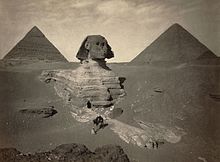
The Sphinx dates from the reign of kingKhafre.[13]During the New Kingdom,Amenhotep IIdedicated a new temple to Hauron-Haremakhet and this structure was added onto by later rulers.[10]: 39–40
Tomb of Queen Khentkaus I
[edit]Khentkaus Iwas buried in Giza. Her tomb is known as LG 100 and G 8400 and is located in theCentral Field,near the valley temple ofMenkaure.The pyramid complex of Queen Khentkaus includes her pyramid, a boat pit, a valley temple, and a pyramid town.[10]: 288–289
Construction
[edit]Most construction theories are based on the idea that the pyramids were built by moving huge stones from a quarry and dragging and lifting them into place. Disagreements arise over the feasibility of the different proposed methods by which the stones were conveyed and placed.
In building the pyramids, the architects might have developed their techniques over time. They would select a site on a relatively flat area of bedrock—not sand—which provided a stable foundation. After carefully surveying the site and laying down the first level of stones, they constructed the pyramids in horizontal levels, one on top of the other.
For theGreat Pyramid,most of the stone for the interior seems to have been quarried immediately to the south of the construction site. The smooth exterior of the pyramid was made of a fine grade of white limestone that was quarried across theNile.These exterior blocks had to be carefully cut, transported by river barge to Giza, and dragged up ramps to the construction site. Only a few exterior blocks remain in place at the bottom of the Great Pyramid. During the Middle Ages (5th century to 15th century), people may have taken the rest away for building projects in the city of Cairo.[6]
To ensure that the pyramid remained symmetrical, the exterior casing stones all had to be equal in height and width. Workers might have marked all the blocks to indicate the angle of the pyramid wall and trimmed the surfaces carefully so that the blocks fit together. During construction, the outer surface of the stone was smooth limestone; excess stone has eroded over time.[6]
New insights into the closing stages of the Great Pyramid building were provided by the recent find ofWadi el-Jarfpapyri, especially thediary of inspector Merer,whose team was assigned to deliver the white limestone fromTuraquarries to Giza. The journal was already published,[14]as well as a popular account of the importance of this discovery.[15]
Purpose
[edit]The pyramids of Giza and others are thought to have been constructed to house the remains of the deceasedpharaohswho ruledAncient Egypt.[6]A portion of the pharaoh's spirit called hiskawas believed to remain with his corpse. Proper care of the remains was necessary in order for the "former Pharaoh to perform his new duties as king of the dead". It is theorized the pyramid not only served as a tomb for the pharaoh, but also as a storage pit for various items he would need in the afterlife. The people of Ancient Egypt believed that death on Earth was the start of a journey to the next world. The embalmed body of the king was entombed underneath or within the pyramid to protect it and allow his transformation and ascension to theafterlife.[16]
Astronomy
[edit]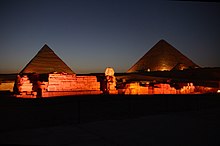
The sides of all three of the Giza pyramids wereastronomicallyoriented to thecardinal directionswithin a small fraction of a degree.[17][18]According to the disputedOrion correlation theory,the arrangement of the pyramids is a representation of the constellationOrion.
Workers' village
[edit]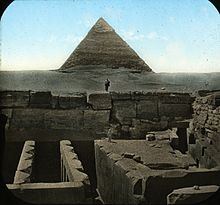

The work of quarrying, moving, setting, and sculpting the huge amount of stone used to build the pyramids might have been accomplished by several thousand skilled workers, unskilled laborers and supporting workers. Bakers, carpenters, water carriers, and others were also needed for the project. Along with the methods used to construct the pyramids, there is also wide speculation regarding the exact number of workers needed for a building project of this magnitude. When Greek historianHerodotusvisited Giza in 450 BC, he was told by Egyptian priests that "the Great Pyramid had taken 400,000 men 20 years to build, working in three-month shifts 100,000 men at a time." Evidence from the tombs indicates that a workforce of 10,000 laborers working in three-month shifts took around 30 years to build a pyramid.[6]
The Giza pyramid complex is surrounded by a large stone wall, outside whichMark Lehnerand his team discovered a town where the pyramid workers were housed. The village is located to the southeast of theKhafreandMenkaurecomplexes. Among the discoveries at the workers' village are communal sleeping quarters, bakeries, breweries, and kitchens (with evidence showing that bread, beef, and fish were dietary staples), a copper workshop, a hospital, and a cemetery (where some of the skeletons were found with signs of trauma associated with accidents on a building site).[19]The metal processed at the site was the so-calledarsenical copper.[20]The same material was also identified among the copper artefacts from the "Kromer" site, from the reigns of Khufu and Khafre.[21]
The workers' town appears to date from the middle4th Dynasty(2520–2472 BC), after the accepted time of Khufu and completion of the Great Pyramid. According to Lehner and the AERA team:
- The development of this urban complex must have been rapid. All of the construction probably happened in the 35 to 50 years that spanned the reigns of Khafre and Menkaure, builders of the Second and Third Giza Pyramids.
Using pottery shards, seal impressions, and stratigraphy to date the site, the team further concludes:
- The picture that emerges is that of a planned settlement, some of the world's earliest urban planning, securely dated to the reigns of two Giza pyramid builders: Khafre (2520–2494 BC) and Menkaure (2490–2472 BC).[22][23]
Radiocarbon data for the Old Kingdom Giza plateau and the workers' settlement were published in 2006,[24]and then re-evaluated in 2011.[25]
Cemeteries
[edit]As the pyramids were constructed, themastabasfor lesser royals were constructed around them. Near the pyramid of Khufu, the main cemetery is G 7000, which lies in the East Field located to the east of the main pyramid and next to the Queen's pyramids. These cemeteries around the pyramids were arranged along streets and avenues.[26]Cemetery G 7000 was one of the earliest and contained tombs of wives, sons, and daughters of these4th Dynastyrulers. On the other side of the pyramid in the West Field, the royals' sonsWepemnofretandHemiunuwere buried in Cemetery G 1200 and Cemetery G 4000, respectively. These cemeteries were further expanded during the5thand6th Dynasties.[10]
West Field
[edit]The West Field is located to the west of Khufu's pyramid. It is divided into smaller areas such as the cemeteries referred to as the Abu Bakr Excavations (1949–1950, 1950–1951, 1952, and 1953), and several cemeteries named based on themastabanumbers such as Cemetery G 1000, Cemetery G 1100, etc. The West Field contains Cemetery G1000 – Cemetery G1600, and Cemetery G 1900. Further cemeteries in this field are: Cemeteries G 2000, G 2200, G 2500, G 3000, G 4000, and G 6000. Three other cemeteries are named after their excavators: Junker Cemetery West, Junker Cemetery East, and Steindorff Cemetery.[10]: 100–122
| Cemetery | Time Period | Excavation | Comments |
|---|---|---|---|
| Abu Bakr Excavations | the5thand6th Dynasty | (1949–1953) | |
| Cemetery G 1000 | the 5th and 6th Dynasty | Reisner (1903–1905) | Stone built mastabas |
| Cemetery G 1100 | the 5th and 6th Dynasty | Reisner (1903–1905) | Brick built mastabas |
| Cemetery G 1200 | Mainly4th Dynasty | Reisner (1903–1905) | Some members ofKhufu's family are buried here; Wepemnefert (King's Son), Kaem-ah (King's Son),Nefertiabet(King's Daughter) |
| Cemetery G 1300 | the 5th and 6th Dynasty | Reisner (1903–1905) | Brick built mastabas |
| Cemetery G 1400 | the 5th Dynasty or later | Reisner (1903–1905) | Two men who were prophets of Khufu |
| Cemetery G 1500 | Reisner (1931?) | Only one mastaba (G 1601) | |
| Cemetery G 1600 | the 5th Dynasty or later | Reisner (1931) | Two men who were prophets of Khufu |
| Cemetery G 1900 | Reisner (1931) | Only one mastaba (G 1903) | |
| Cemetery G 2000 | the 5th and 6th Dynasty | Reisner (1905–1906) | |
| Cemetery G 2100 | the 4th and 5th Dynasty and later | Reisner (1931) | G 2100 belongs to Merib, a King's (grand-)Son and G2101 belongs to a 5th Dynasty king's daughter. |
| Cemetery G 2200 | Late 4th or early 5th Dynasty | Reisner? | Mastaba G 2220 |
| Cemetery G 2300 | 5th Dynasty and 6th Dynasty | Reisner (1911–1913) | Includes mastabas of Vizier Senedjemib-Inti and his family. |
| Cemetery G 2400 | 5th Dynasty and 6th Dynasty | Reisner (1911–1913) | |
| Cemetery G 2500 | Reisner | ||
| Cemetery G 3000 | 6th Dynasty | Fisher and Eckley Case Jr. (1915) | |
| Cemetery G 4000 | 4th Dynasty and later | Junker and Reisner (1931) | Includes tomb of the vizierHemiunu |
| Cemetery G 6000 | 5th Dynasty | Reisner (1925–1926) | |
| Junker Cemetery (West) | LateOld Kingdom | Junker (1926–1927) | Includes mastaba of the dwarfSeneb |
| Steindorff Cemetery | 5th Dynasty and 6th Dynasty | Steindorff (1903–1907) | |
| Junker Cemetery (East) | Late Old Kingdom | Junker |
East Field
[edit]The East Field is located to the east of Khufu's pyramid and contains cemetery G 7000. This cemetery was a burial place for some of the family members of Khufu. The cemetery also includes mastabas from tenants and priests of the pyramids dated to the 5th Dynasty and 6th Dynasty.[10]: 179–216
| Tomb number | Owner | Comments |
|---|---|---|
| G 7000 X | Queen Hetepheres I | Mother ofKhufu |
| G 7010 | Nefertkau I | Daughter ofSneferu,half-sister of Khufu |
| G 7060 | Nefermaat I | Son ofNefertkau Iand Vizier ofKhafre |
| G 7070 | Sneferukhaf | Son ofNefermaat II |
| G 7110–7120 | KawabandHetepheres II | Kawab was the eldest son of Khufu |
| G 7130–7140 | Khufukhaf IandNefertkau II | King's Son and Vizier and his wife |
| G 7210–7220 | Djedefhor | King's Son of Khufu and Meritites |
| G 7350 | Hetepheres II | Wife ofKawaband later wife ofDjedefre |
| G 7410–7420 | Meresankh IIandHorbaef | Meresankh was a king's daughter and king's wife |
| G 7430–7440 | Minkhaf I | Son of Khufu andVizierofKhafre |
| G 7510 | Ankhhaf | Son ofSneferuand Vizier ofKhafre |
| G 7530–7540 | Meresankh III | Daughter ofKawabandHetepheres II,wife ofKhafre |
| G 7550 | Duaenhor | Probably son ofKawaband thus a grandson of Khufu |
| G 7560 | Akhethotep andMeritites II | Meritites is a daughter of Khufu |
| G 7660 | Kaemsekhem | Son of Kawab, a grandson of Khufu, served as Director of the Palace |
| G 7760 | Mindjedef | Son of Kawab, a grandson of Khufu, served as Treasurer |
| G 7810 | Djaty | Son of QueenMeresankh II |
Cemetery GIS
[edit]This cemetery dates from the time ofMenkaure(Junker) or earlier (Reisner), and contains several stone-built mastabas dating from as late as the6th Dynasty.Tombs from the time ofMenkaureinclude the mastabas of the royal chamberlain Khaemnefert, the King's son Khufudjedef (master of the royal largesse), and an official named Niankhre.[10]: 216–228
Central Field
[edit]The Central Field contains several burials of royal family members. The tombs range in date from the end of the4th Dynastyto the5th Dynastyor even later.[10]: 230–293
| Tomb number | Owner | Comments |
|---|---|---|
| G 8172 (LG 86) | Nebemakhet | Son ofKhafre,served as vizier |
| G 8158 (LG 87) | Nikaure | Son ofKhafreand Persenet, served as vizier |
| G 8156 (LG 88) | Persenet | Wife ofKhafre |
| G 8154 (LG 89) | Sekhemkare | Son ofKhafreandHekenuhedjet |
| G 8140 | Niuserre | Son ofKhafre,Vizier in the 5th Dynasty |
| G 8130 | Niankhre | King's Son, probably 5th Dynasty |
| G 8080 (LG 92) | Iunmin | King's Son, end of 4th Dynasty |
| G 8260 | Babaef | Son ofKhafre,end of 4th Dynasty |
| G 8466 | Iunre | Son ofKhafre,end of 4th Dynasty |
| G 8464 | Hemetre | Probably daughter ofKhafre,end of 4th Dynasty or 5th Dynasty |
| G 8460 | Ankhmare | King's son and vizier, end of 4th Dynasty |
| G 8530 | Rekhetre | King's daughter (ofKhafre) and Queen, end of 4th Dynasty or 5th Dynasty |
| G 8408 | Bunefer | King's daughter and Queen, end of 4th Dynasty or 5th Dynasty |
| G 8978 | Khamerernebty I | King's daughter and Queen, middle to end of 4th Dynasty. Also known as the Galarza Tomb |
Tombs dating from theSaiteand later period were found near the causeway of Khafre and the Great Sphinx. These tombs include the tomb of a commander of the army named Ahmose and his mother Queen Nakhtubasterau, who was the wife ofPharaohAmasis II.[10]: 289–290
South Field
[edit]The South Field includes mastabas dating from the1st Dynastyto3rd Dynastyas well as later burials.[27]Of the more significant of these early dynastic tombs are one referred to as "Covington's tomb", otherwise known as Mastaba T, and the large Mastaba V which contained artifacts naming the 1st Dynasty pharaohDjet.[28][27]Other tombs date from the lateOld Kingdom(5th and 6th Dynasty). The south section of the field contains several tombs dating from theSaiteperiod and later.[10]: 294–297
Tombs of the pyramid builders
[edit]In 1990, tombs belonging to the pyramid workers were discovered alongside the pyramids, with an additional burial site found nearby in 2009. Although not mummified, they had been buried inmudbricktombs with beer and bread to support them in the afterlife. The tombs' proximity to the pyramids and the manner of burial supports the theory that they were paid laborers who took pride in their work and were not slaves, as was previously thought. Evidence from the tombs indicates that a workforce of 10,000 laborers working in three-month shifts took around 30 years to build a pyramid. Most of the workers appear to have come from poor families. Specialists such as architects, masons, metalworkers, and carpenters were permanently employed by the king to fill positions that required the most skill.[29][30][31][32]
Shafts
[edit]There are multipleburial-shaftsand various unfinished shafts and tunnels located in the Giza complex that were discovered and mentioned prominently bySelim Hassanin his reportExcavations at Giza 1933–1934.[33]He states: "Very few of the Saitic [referring to theSaite Period][34]shafts have been thoroughly examined, for the reason that most of them are flooded. "[33]: 193
Osiris Shaft
[edit]The Osiris Shaft is a narrow burial-shaft leading to three levels for a tomb and below it a flooded area.[35]It was first mentioned by Hassan, and a thorough excavation was conducted by a team led byHawassin 1999.[36]It was opened to tourists in November 2017.[37]
New Kingdom and Late Period
[edit]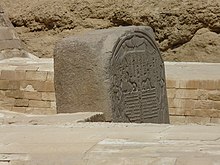
During theNew KingdomGiza was still an active site. A brick-built chapel was constructed near the Sphinx during the early18th Dynasty,probably by KingThutmose I.Amenhotep IIbuilt a temple dedicated to Hauron-Haremakhet near the Sphinx. As a prince, the future pharaohThutmose IVvisited the pyramids and the Sphinx; he reported being told in a dream that if he cleared the sand that had built up around the Sphinx, he would be rewarded with kingship. This event is recorded in theDream Stele,which he had installed between the Sphinx's front legs.
During the early years of his reign, Thutmose IV, together with his wife Queen Nefertari, had stelae erected at Giza.
PharaohTutankhamunhad a structure built, which is now referred to as the king's resthouse.
During the19th Dynasty,Seti Iadded to the temple of Hauron-Haremakhet, and his sonRamesses IIerected a stela in the chapel before the Sphinx and usurped the resthouse of Tutankhamun.[10]: 39–47
During the21st Dynasty,the Temple of Isis Mistress-of-the-Pyramids was reconstructed. During the26th Dynasty,a stela made in this time mentions Khufu and his QueenHenutsen.[10]: 18
Division of the 1903–1905 excavation of the Giza Necropolis
[edit]In 1903, rights to excavate the West Field and Pyramids of the Giza Necropolis were divided by three institutions from Italy, Germany, and the United States of America.
Background
[edit]Prior to the division of the Giza Plateau into three institutional concessions in 1903, amateur and private excavations at the Giza Necropolis had been permitted to operate. The work of these amateur archaeologists failed to meet high scientific standards. Montague Ballard, for instance, excavated in the Western Cemetery (with the hesitant permission of the Egyptian Antiquities Service) and neither kept records of his finds nor published them.[38][39][40]
Italian, German, and American Concessions at Giza
[edit]In 1902, the Egyptian Antiquities Service underGaston Masperoresolved to issue permits exclusively to authorized individuals representing public institutions.[41]In November of that year, the Service awarded three scholars with concessions on the Giza Necropolis. They were the ItalianErnesto Schiaparellifrom the Turin Museum, the GermanGeorg Steindorfffrom the University of Leipzig who had funding from Wilhelm Pelizaeus, and the AmericanGeorge Reisnerfrom the Hearst Expedition. Within a matter of months, the site had been divided between the concessionaires following a meeting at the Mena House Hotel involving Schiaparelli,Ludwig Borchardt(Steindorff's representative in Egypt), and Reisner.[42]
Division of the West Field
[edit]By the turn of the 20th century, the three largest pyramids on the Giza plateau were considered mostly exhausted by previous excavations, so the Western Cemetery and its collection of private mastaba tombs were thought to represent the richest unexcavated part of the plateau. George Reisner's wife, Mary, drew names from a hat to assign three long east-west plots of the necropolis among the Italian, German, and American missions. Schiaparelli was assigned the southernmost strip, Borchardt the center, and Reisner the northernmost.[43]
Division of the Pyramids
[edit]Rights to excavate the Pyramids were then also negotiated between Schiaparelli, Borchardt, and Reisner. Schiaparelli gained rights to excavate the Great Pyramid of Khufu along with its three associated queens' pyramids and most of its Eastern Cemetery. Borchardt received Khafre's pyramid, its causeway, the Sphinx, and the Sphinx's associated temples. Reisner claimed Menkaure's pyramid as well as its associated queens' pyramids and pyramid temple, along with a portion of Schiaparelli's Eastern Cemetery. Any future disputes were to be resolved by InspectorJames Quibell,as per a letter from Borchardt to Maspero.[44]
Immediate Aftermath
[edit]This arrangement lasted until 1905, when, under the supervision of Schiaparelli and Francesco Ballerini, the Italian excavations ceased at Giza. As the Italians were more interested in sites which might yield more papyri, they turned their concession of the southern strip of the Western Cemetery over to the Americans under Reisner.[45]
Modern usage
[edit]In 1978, theGrateful Deadplayed a series of concerts later released asRocking the Cradle: Egypt 1978.In 2007, Colombian singerShakiraperformed at the complex to a crowd of approximately 100,000 people.[46]The complex was used for the final draw of the2019 Africa Cup of Nationsand the2021 World Men's Handball Championship.
Egypt'sMinister of Tourismunveiled plans for a€17,000,000 revamp of the complex by the end of 2021, in order to boosttourism in Egyptas well as make the site more accessible and tourist-friendly.[47][48]According toLonely Planet,the refurbishment includes a new visitors' centre, an environmentally-friendly electric bus, a restaurant (the 9 Pyramids Lounge),[49]as well as a cinema, public toilets, site-wide signage, food trucks, photo booths, and free Wi-Fi.[50][51][52]The new facility is part of awider planto renovate the 4,500 year old site.[53]
See also
[edit]- Egyptian pyramids
- List of Egyptian pyramids
- List of largest monoliths,includes section on calculating weight of megaliths
- Outline of Egypt
- Teotihuacan
References
[edit]- ^ab"Memphis and its Necropolis – the Pyramid Fields from Giza to Dahshur".UNESCO World Heritage Centre.United Nations Educational, Scientific, and Cultural Organization.Retrieved7 September2021.
- ^Some medieval visitors, however, viewed them as "the Granaries of Joseph", such as the Spanish travellerPedro Tafurin 1436 (Pedro Tafur,Andanças e viajes).
- ^Bard, Kathryn A. (1994)."The Egyptian Predynastic: A Review of the Evidence".Journal of Field Archaeology.21(3): 265–288.doi:10.1179/009346994791547553.ISSN0093-4690.
- ^Sanussi, Ashraf el-; Jones, Michael (1997). "A site of the Maadi culture near the Giza pyramids".Mitteilungen des Deutschen Archäologischen Instituts, Abteilung Kairo.53:241–253.S2CID192152723.
- ^Bajeot, Jade (2017).Predynastic Maadi in context: the research of the Italian expedition revisited (1977–1986).Studi di preistoria orientale. Rome: Dipartimento di scienze dell'antichità, Sapienza Università di Roma.ISBN978-88-904240-2-1.
- ^abcdefghVerner, Miroslav. The Pyramids: The Mystery, Culture, and Science of Egypt's Great Monuments. Grove Press. 2001 (1997).ISBN0-8021-3935-3
- ^Sheisha, Hader; Kaniewski, David; Marriner, Nick; Djamali, Morteza; Younes, Gamal; Chen, Zhongyuan; El-Qady, Gad; Saleem, Amr; Véron, Alain; Morhange, Christophe (13 September 2022)."Nile waterscapes facilitated the construction of the Giza pyramids during the 3rd millennium BCE".Proceedings of the National Academy of Sciences.119(37): e2202530119.Bibcode:2022PNAS..11902530S.doi:10.1073/pnas.2202530119.ISSN0027-8424.PMC9477388.PMID36037388.
- ^Shafer, Byron E.; Arnold, Dieter (2005).Temples of Ancient Egypt.I.B. Tauris. pp. 51–52.ISBN978-1-85043-945-5.
- ^Arnold, Dieter; Strudwick, Nigel; Strudwick, Helen (2002).The encyclopaedia of ancient Egyptian architecture.I.B. Tauris. p.126.ISBN978-1-86064-465-8.
- ^abcdefghijklmnopqPorter, BerthaandMoss, Rosalind L. B.Topographical Bibliography of Ancient Egyptian Hieroglyphic Texts, Reliefs, and Paintings. Volume III. Memphis. Part I. Abû Rawâsh to Abûṣîr.2nd edition, revised and augmented by Jaromír Málek, The Clarendon Press, Oxford 1974.PDF from The Giza Archives, 29,5 MBRetrieved 10 February 2017.
- ^"A team from the Grand Egyptian Museum succeeded in the first trial run conducted to test the vehicles that will be used in the transferring the first Khufu Solar Boat from its current location".Ministry of Tourism and Antiquities.2019.Retrieved8 March2022.
- ^"In pictures: Egypt pharaoh's 'solar boat' moved to Giza museum".BBC News.7 August 2021.Retrieved7 August2021.
- ^"Riddle of the Sphinx".Documentary Storm.23 December 2009.Retrieved4 August2023.
- ^Tallet, Pierre (2017).Les papyrus de la mer Rouge: papyrus Jarf A et B.MIFAO (in French). Le Caire: Institut français d'archéologie orientale.ISBN978-2-7247-0706-9.
- ^Tallet, Pierre; Lehner, Mark (2021).The Red Sea scrolls: how ancient papyri reveal the secrets of the pyramids.London New York, New York: Thames & Hudson Ltd.ISBN978-0-500-05211-2.
- ^"Egypt pyramids".culturefocus. Archived fromthe originalon 2 January 2010.
- ^Spence, Kate (16 November 2000)."Ancient Egyptian chronology and the astronomical orientation of pyramids".Nature.412(408): 320–324.doi:10.1038/35042510.Retrieved28 December2023.
- ^"The Great Pyramid: Star Fixed, When?"(PDF).DIO: The International Journal of Scientific History.13(1): 2–11. December 2003.ISSN1041-5440.Retrieved9 March2022.
- ^Lehner, Mark (2002)."The Pyramid Age Settlement of the Southern Mount at Giza".Journal of the American Research Center in Egypt.39:27–74.doi:10.2307/40001149.JSTOR40001149.
- ^Odler, Martin; Kmošek, Jiří (2019)."Copper at Giza: the Latest News"(PDF).Aeragram.20(2): 12–17.
- ^Odler, Martin; Kmošek, Jiří; Fikrle, Marek; Erban Kochergina, Yulia V. (2021)."Arsenical copper tools of Old Kingdom Giza craftsmen: First data".Journal of Archaeological Science: Reports.36:102868.Bibcode:2021JArSR..36j2868O.doi:10.1016/j.jasrep.2021.102868.S2CID233577883– via Elsevier Science Direct.
- ^"Egyptian Pyramids – Lost City of the Pyramid Builders – AERA – Ancient Egypt Research Associates".aeraweb.org.10 September 2009.
- ^Lehner, Mark (14 October 2009)."Dating the Lost City of the Pyramids".aeraweb.org.Ancient Egypt Research Associates.
- ^Bonani, Georges; Haas, Herbert; Hawass, Zahi; Lehner, Mark; Nakhla, Shawki; Nolan, John; Wenke, Robert; Wölfli, Willy (2001)."Radiocarbon Dates of Old and Middle Kingdom Monuments in Egypt".Radiocarbon.43(3): 1297–1320.Bibcode:2001Radcb..43.1297B.doi:10.1017/S0033822200038558.ISSN0033-8222.
- ^Dee, M. W.; Bronk Ramsey, C.; Shortland, A. J.; Higham, T. F. G.; Rowland, J. M. (2009)."Reanalysis of the Chronological Discrepancies Obtained by the Old and Middle Kingdom Monuments Project".Radiocarbon.51(3): 1061–1070.Bibcode:2009Radcb..51.1061D.doi:10.1017/S0033822200034111.ISSN0033-8222.
- ^Lehner, Mark, "The Complete Pyramids",Thames & Hudson,1997.ISBN0-500-05084-8.
- ^abPetrie, W. M. Flinders;et al. (1907).Gizeh and Rifeh(PDF).London: School of Archaeology in Egypt. pp. 2–8.Retrieved4 April2019.
- ^Flentye, Laurel (March 2018)."The Art and Archaeology of the Giza Plateau".Online Only – Archaeology.doi:10.1093/oxfordhb/9780199935413.013.29.ISBN978-0-19-993541-3.
- ^"Who Built the Pyramids?".Explore the pyramids.Archived fromthe originalon 16 September 2002.Retrieved27 August2010.
- ^"The Discovery of the Tombs of the Pyramid Builders at Giza: Dr. Zahi Hawass".guardians.net.Retrieved4 August2023.
- ^The Cemetery of the Pyramid BuildersArchived15 September 2010 at theWayback Machineby Zahi Hawass
- ^Cooney, Kathlyn (2007). "Labour". In Wilkinson, Toby (ed.).The Egyptian World.Routledge.
- ^ab"Digital Giza | Excavations at Gîza 5: 1933–1934".giza.fas.harvard.edu.Retrieved24 October2019.
- ^Carolinarh (29 April 2013)."Saitic Period".ArS Artistic Adventure of Mankind.Retrieved24 October2019.
- ^"Pyramids of Giza (pyramids, Egypt)".Encyclopedia Britannica.Retrieved24 October2019.
- ^Kmtsesh (18 February 2012)."The Osiris Shaft: a Giza cenotaph".Ancient Near East: Just the Facts.Archived fromthe originalon 24 August 2019.Retrieved24 October2019.
- ^First Time Exploring The Astonishing Osiris Shaft on the Giza Plateau,archivedfrom the original on 13 December 2021,retrieved24 October2019
- ^P. D. Manuelian, Walking Among Pharaohs: George Reisner and the Dawn of Modern Egyptology (Oxford University Press, Oxford, 2023).
- ^A. Spiekermann, "Steindorff und Mastaba G 2005" in Zur Zierde gereicht... Festschrift Bettina Schmitz zum 60. Geburtstag am 24. Juli 2008, Hildesheimer Ägyptologische Beiträge 50, A. Spiekermann, Ed. (Verlag Gebrüder Gerstenberg, Hildesheim, 2008), pp. 241–249.
- ^"Montague Ballard".Digital Giza.Giza Project at Harvard.Retrieved4 August2023.
- ^P. D. Manuelian, Walking Among Pharaohs: George Reisner and the Dawn of Modern Egyptology (Oxford University Press, Oxford, 2023).
- ^G. A. Reisner, A History of the Giza Necropolis. Volume I (Harvard University Press, Cambridge, Massachusetts, 1942).
- ^P. D. Manuelian, Walking Among Pharaohs: George Reisner and the Dawn of Modern Egyptology (Oxford University Press, Oxford, 2023).
- ^E. David, Gaston Maspero. Lettres d'Egypte. Correspondence avec Louise Maspero [1883–1914] (Editions du Seuil, Paris, 2003).
- ^P. D. Manuelian, Walking Among Pharaohs: George Reisner and the Dawn of Modern Egyptology (Oxford University Press, Oxford, 2023).
- ^H. A. R. (31 March 2007)."Shakira Rocks the Pyramids of Giza".Waleg.Archived fromthe originalon 31 December 2018.Retrieved11 January2022.
- ^Sanders, Laura (7 January 2021)."Egypt's Giza Pyramids are getting a revamp to boost tourism".euronews.Retrieved19 March2021.
- ^"Egypt to build first restaurant serving tourists at Great Pyramids of Giza: Minister".Egypt Independent.5 February 2020.Retrieved19 March2021.
- ^"9 Pyramids Lounge: Everything to know about Egypt's First Restaurant At Giza Pyramids".El-Shai.21 October 2020.Retrieved24 April2021.
- ^"New cafe at the Pyramids of Giza to open soon as part of revamp".Lonely Planet.Retrieved19 March2021.
- ^"In Photos: A Look At the First Restaurant Near Giza Pyramids | Egyptian Streets".28 July 2020.Retrieved19 March2021.
- ^"The Pyramids of Giza Are Getting a New Cafe, Lounge, and Visitor's Center by 2021".Scoop Empire.27 October 2020.Retrieved19 March2021.
- ^"Pyramids of Giza Is Getting a New Visitors Center Complete With a Lounge, Cinema, and More".Travel + Leisure.Retrieved19 March2021.
External links
[edit]- Giza Plateau
- Pyramids in Giza– Pictures of Giza Pyramids published underCreative Commons License.
- Website of theAncient Egypt Research Associates,researching Giza for over 30 years
- 3D virtual tour explaining Houdin's theoryArchived28 July 2011 at theWayback Machine(plug in needed)
- The Giza Archives at Harvard University– since 2010, theOld Giza ProjectwebsiteArchived11 October 2008 at theWayback Machinemaintained by theMuseum of Fine Arts,in Boston, has moved toHarvard Universitywith an improved, expanded website. This website is a comprehensive resource for research on Giza. It contains photographs and other documentation from the original Harvard University –Boston Museum of Fine Arts Expedition(1904 to 1947), from recent MFA fieldwork, and from other expeditions, museums, and universities around the world.


